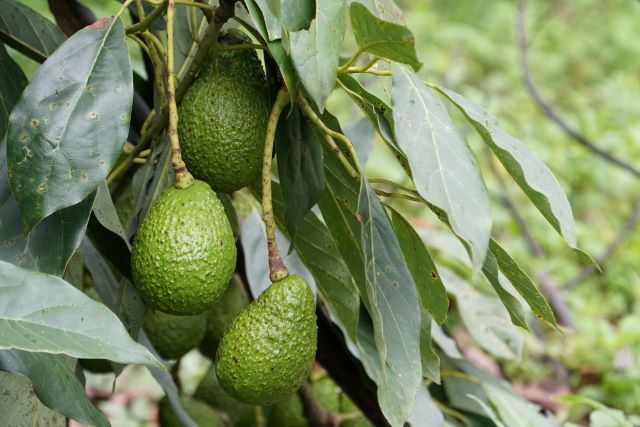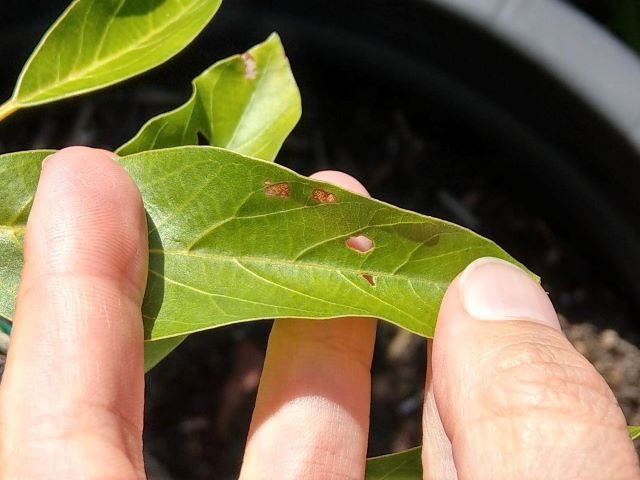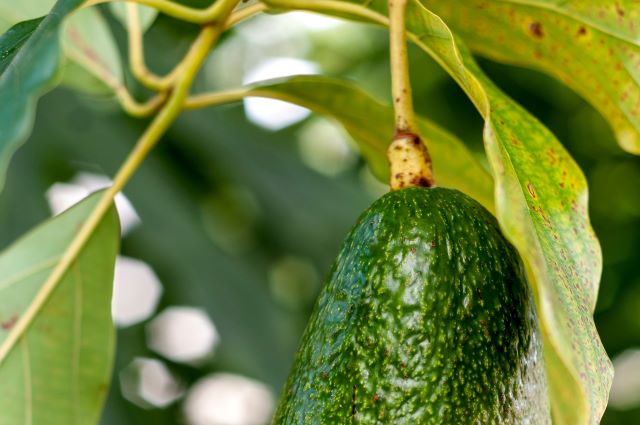Avocado trees take an average of 7 years to start bearing fruit. So planting an avocado tree is a long-term investment. They are not easy trees to grow and are prone to disease and are generally quite vulnerable. So if you see brown spots on the leaves of your avocado tree you need to act quickly in order to save it. There are a number of things that can cause the leaves of an avocado tree to turn brown.

Table of Contents
- What Causes Brown Spots on Avocado Leaves?
- Persea Mite Cause Brown Spots on Avocado Leaves
- Six-Spotted Mite Causes Brown Spots on Avocado Leaves
- Brown Mites Cause Avocado Leaves to Brown
- Avocado Lace Bug Cause Brown Spots on Leaves
- Avocado Thrips Cause Brown Spots on Leaves
- Algal Leaf Spot Causes Spots on Avocado Leaves
- Anthracnose Causes Brown Spots on Avocado Leaves
- Septoria Leaf Spot Causes Brown Spots on Avocado Leaves
- Alternaria Leaf Blight Causes Brown Spots on Avocado Leaves
- Downy Mildew Causes Brown Spots on Avocado Leaves
- Powdery Mildew Causes Brown Spots on Avocado Leaves
- Bacterial Soft Rot Causes Brown Spots on Avocado Leaves
- Edema Causes Brown Spots on Avocado Leaves
- Scorching Causes Brown Spots on Avocado Leaves
- Iron Deficiency Causes Brown Spots on Avocado Leaves
- Nitrogen Deficiency Causes Brown Spots on Avocado Leaves
What Causes Brown Spots on Avocado Leaves?
Most brown spots on the leaves of your avocado tree are caused by insects, fungus, bacteria or mineral deficiencies. Most of these ailments are exacerbated by wet, humid weather and over-watering.
Brown spots on avocado leaves can be caused by a variety of pests including persea mite, six-spotted mite, brown mites, avocado lace bug, avocado thrips and algal leaf spot.
Fungal infections also cause brown spots. These include avocado scabbing, anthracnose, septoria leaf spot and alternaria leaf blight. Both powdery mildew and downy mildew cause brown spots on avocado leaves.
Scorching, or burning from harsh direct sunlight can cause brown spots.
Bacterial infection is not as common as fungal infection but it does occur. Edema is caused when too much water is absorbed for the leaves to handle and the cells stretch and burst.
A deficiency in minerals such as iron and nitrogen can cause brown spots on the leaves.
Most of these ailments can be combatted by reducing humidity and ensuring sufficient air-flow and sunlight reach the avocado tree.
Let’s look at these causes in more detail and how you can solve them using natural and organic gardening methods.

Persea Mite Cause Brown Spots on Avocado Leaves
The most common cause of brown spots on avocado leaves is mite or fungus infestation. The Persea mite occurs predominantly in California and it is rare to find it anywhere else.
They feed underneath the leaves and leave a dense telltale webbing. The brown spots caused by these mites are found underneath the leaf and occur as small circles. They are usually concentrated along the vein. They become darker and darker until they are visible from the top side of the leaf.
Solution: The webbing protects the mites from natural predators so by destroying the webbing you should rid yourself of the problem. You can destroy the webbing by blasting the leaves with a high-pressure hose. This should also dislodge a large number of the mites.
If you only have one or two small trees, you could remove the webbing by hand and rub off most of the mites. Use a dilution of rubbing alcohol and water to spray or wipe away the mites.
Certain essential oils have also been known to kill mites, namely: rosemary, chamomile, spearmint and coriander. Dilute according to instructions on the bottle and spray onto the leaves.
Six-Spotted Mite Causes Brown Spots on Avocado Leaves
This mite also feeds on the underside of the leaves. The brown spots caused by these mites are large irregular blotches. The blotches are usually dark brown but they can also be a purplish color. The mites create a protective silvery webbing on the underside of the leaf.
Solution: Use a high-pressure hose to blast the webbing off the leaf. The webbing is the mites’ protection and without it their natural predators should take care of the problem for you.
If you only have a few, small trees you can remove the webbing by hand. Dilute a little rubbing alcohol in water. Use a cloth soaked in this mixture to wipe the leaves.
Alternately you can spray the mixture onto the leaves and wipe it off after a few minutes.
Mites are also deterred by any form of chili. Blend one teaspoon of cayenne pepper in one cup of water. Or blend one hot chili pepper in one cup of water. Spray the mixture onto the leaves.
Brown Mites Cause Avocado Leaves to Brown
These little mites don’t leave brown spots on the leaves but rather cause the whole leaf to turn brownish.
Avocado Lace Bug Cause Brown Spots on Leaves
These lacy bugs feed on the juices in the avocado leaves. In small numbers, they are relatively harmless but in large numbers, they cause yellow-brown spots on the leaves.
They feed underneath the leaf and leave dark brown or black fecal droppings. They lay their eggs in the leaves so new baby bugs will hatch out and feed on your avocado leaves. It is best to get rid of the eggs as well as the bugs if you want to rid yourself of the infestation.
Solution: As with mites, the best way to get lace bugs off the avocado leaves is to blast them with a high-pressure hose. This will, hopefully, dislodge most of the eggs as well.
If you don’t have a high-pressure hose and you have a small tree you can manually remove the bugs by wiping each leaf with a damp cloth. You will need to wipe rather firmly to remove the eggs as well.
For extra effect, you can soak the cloth in a solution of rubbing alcohol and water.
Avocado Thrips Cause Brown Spots on Leaves
Thrips are small, 3/64 inch (1mm) in size, yellow insects. They can fly but they tend to spread through the wind. They attack the tips and edges of the avocado leaves and they leave honeydew residue that encourages fungus.
The leaves develop brown spots and dark leathery patches on the upper side of the leaf. Sometimes you will also see black fecal remnants.
Solution: These bugs have many natural predators and thus should be controlled naturally. Remove ants from the plant to allow the natural predators to feed on the thrips.
If the thrip infestation is bad you can wash the avocado leaves with soapy water. Dilute 5 tablespoons of liquid soap in 1 gallon of water. Spray the soapy water all over the avocado tree. Spray around the base of the tree to kill any developing nymphs.
Sticky traps such as these ones can also be used to combat thrips infestation. Thrips are attracted to the colors blue and yellow.
Algal Leaf Spot Causes Spots on Avocado Leaves

Algal leaf spot usually attacks the bottom most leaves of the avocado tree. It causes little rust-colored raised spots. When the spots are removed, the leaf is dark grey underneath. Luckily this parasitic algae is easy to combat.
Solution: Algal leaf spot requires a moist environment to survive. If your avocado tree is in a pot, move it into the sunlight. This should allow all areas on the tree to dry completely thus eradicating the algal leaf spot.
Also, check that your pot is draining efficiently. There should be no excess water in the pot dish. You can happily prune the infected leaves away. This will rid you of the problem and allow new, healthy leaves to grow.
Pruning will also allow for air to circulate better around the tree and thus help with drying moist areas and eradicating the parasitic algae.
Anthracnose Causes Brown Spots on Avocado Leaves
This is a deadly fungus. It will begin as yellow to brown spots and will slowly spread across the avocado leaf. It also causes the leaf tips to turn brown. Over time the leaves will die and fall off.
Most fungal infections are caused by a humid environment and insufficient drainage.
Solution: increasing air circulation and lowering humidity levels will help to eradicate the fungus. Prune back the lower hanging branches and twigs to at least 2-feet above ground level. This will help to increase air circulation.
Check the drainage of your pot and remove excess water.
Isolate your avocado tree if possible to prevent the fungus from spreading to other plants.
Allow enough sunlight to reach your avocado tree to dry any moist areas.
Septoria Leaf Spot Causes Brown Spots on Avocado Leaves
This fungus is common in many vegetables. Septoria Leaf Spot occurs on the underside of the avocado leaves where it causes brown spots. The affected avocado leaves will eventually turn yellow and and wither to brown.
Solution: Cut off all infected areas. Do not place pruned pieces in the compost heap as the spores will thrive and spread to other plants. Rather dispose of them in the garbage or burn them.
Sterilize your tools and hands after you have finished working with infected trees to ensure you do not spread spores to other plants.
Alternaria Leaf Blight Causes Brown Spots on Avocado Leaves
Alternia Leaf Blight is a fungus that thrives in moist, warm environments and is prevalent in wet, rainy seasons. It causes small brown spots with a yellow rim on avocado leaves. Eventually, the avocado leaves will turn brown and wither.
Solution: Immediately stop watering your avocado tree. Monitor watering carefully being sure not to overwater your tree. If possible, do not sprinkle water over the avocado tree but rather water from the base to keep the leaves dry.
Prune the tree to increase airflow and reduce fungal infection.
Put a layer of compost or mulch around the base of the avocado tree to block spores from coming back up to your plant.
Sterilize tools and hands after working with the infected tree. Dispose of all infected parts of your tree in the garbage not the compost heap.
Downy Mildew Causes Brown Spots on Avocado Leaves
Downy Mildew disease is most common in early spring when the weather is cool and wet. The avocado leaves develop yellow and white patches on the upper surface and a grayish cotton-like substance underneath. The yellow patches will slowly turn brown and the leaf will drop off.
Solution: If your avocado tree is in a pot, try moving it to a warm, well-ventilated area. This will reduce humidity and the warmer temperature will not be pleasant for the mildew.
Water the tree from the base so as to keep the leaves dry.
Powdery Mildew Causes Brown Spots on Avocado Leaves
Powdery Mildew, unlike most fungi, thrives in a hot, dry climate. It prevents the avocado leaf from photosynthesizing. It causes a flour-like dust on the upper surface of the leaves and may cause deformation in the avocado leaf.
Solution: if the avocado tree is in a pot move it to a well-ventilated area. Spray the leaves with a mixture of bicarbonate of soda and water (1 teaspoon baking soda in 1 liter of water) or a DIY Milk Spray such as this one here.
Do not overwater the tree. Make sure the pot dish is free of water.
Bacterial Soft Rot Causes Brown Spots on Avocado Leaves
Bacterial Soft Rot is a bacteria that is spread by insects moving from one plant to another. The bacteria will enter through a wound in your plant.
It causes the plant’s structure to fall apart. The Avocado leaves begin to discolor and yellow-brown spots will occur. The leaves also give off a strong, foul odor.
Solution: Unfortunately, there is no cure at the present time. Once the Bacterial Soft Rot bacteria has entered the tissue of your avocado tree there is nothing you can do.
Edema Causes Brown Spots on Avocado Leaves
Edema is caused when the roots absorb water faster than the leaves can transpire. This results in a build-up of excess water in the avocado leaves.
This usually occurs when there is an abundance of warm water in the soil and a humid environment. As the water builds up in the leaves it causes the epidermal cells in the leaves to stretch until they collapse.
The avocado leaves will develop small brown spots. The veins will become corky and the leaves will take on a crusty texture.
Solution: If your plant is in a pot, make sure it is draining efficiently. Remove any excess water from the pot dish. If this does not help, repot your avocado.
Scorching Causes Brown Spots on Avocado Leaves
Avocado trees like plenty of light but they can be scorched by too much direct sunlight. This often occurs when you plant a potted indoor tree out into the garden. Scorching causes brown blemishes on the leaves and if not treated the leaves will wilt and drop off.
Solution: Move your plant to an area that does not have such harsh sunlight. Easterly facing windows are good. If your avocado tree is planted outdoors, you can cover it with shade-cloth or an umbrella to protect it from harsh direct sunlight.
Iron Deficiency Causes Brown Spots on Avocado Leaves
Avocado leaves deficient in iron will discolor and form brown spots. Leaves may drop off.
Solution: fertilize with peat moss or other organic composts that are high in iron. Blood meal is another good source of iron for plants and can be dug into the soil around your tree.
Nitrogen Deficiency Causes Brown Spots on Avocado Leaves
Nitrogen deficiency occurs in very wet seasons or if you are overwatering your avocado tree. The more water there is the weaker the dilution of nitrogen so, even though the tree is absorbing the same amount of water, it will be absorbing less nitrogen.
A nitrogen deficiency causes the avocado leaves to turn yellowish and dark spots will suddenly appear.
Solution: water moderately and add ammonium nitrate to the soil. Natural nitrogen supplements for plants and your avocado tree are: coffee grounds, bone meal, grass clippings, human urine, alfalfa meal, fish emulsion, manure and leaves.
Further Reading:
- How to Grow Avocados Indoors – And Will They Fruit?
- The Big Mystery of Small Avocados: Solved!
- Can You Eat Unripe Avocados? Answered!
- Why Is My Avocado Bitter? Answered!
- Brown Spots On Peppers: Causes And Solutions
- Peach Tree Leaves Turning Yellow: Causes and Solutions
- Why Is My Papaya Tree Dying? Causes and Solutions
- How Many Pineapples Grow on One Plant? Answered!
